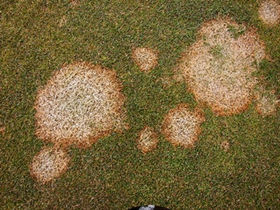Snow Mould and Fusarium
- Do you see patches (25mm to 300mm) of yellow or brown coloured turf?
- Can you see white or pale pink mould on the turf?
- Do you see these symptoms when it is wet or humid, and the grass stays wet for most of the day?
If the answer to these questions is yes, then snow moulds or Fusarium may be present in your turf?
What is it?
Snow moulds and Fusarium are very common diseases of turf within the UK. They start to appear in the autumn of the year, but disease symptoms are only observed in the winter and early spring. They are capable of attacking your grass when the air and soil temperatures are too cold for the grass leaves to grow.
General description of Grey Snow Mould
Grey snow mould is identified by a grey web like structure called Mycelia which can only be seen if the turf is wet. The grey snow mould fungus sometimes produces sclerotia which are hard, small bodies that protect the fungus from drought and heat. These are only found after 3-5 months of cool wet weather, but sometimes they do not form at all.
General description of Fusarium
You will first notice small patches of grass leaves turning yellow or brown develop, sometimes with a white or pink fluffy fungal growth around the edge of the patch. Over a period of weeks these die back and can create areas of bare ground.
Why has it affected my turf?
As with all plant diseases, the spores of this disease are abundant everywhere, but only produce symptoms if environmental conditions are right for their growth.
How can I avoid it developing?
- Avoid over feeding
- Avoid damp, shady locations with little or no air movement.
- In order to keep the lawn surface dry, mow regularly to prevent the leaves of the grass becoming too long
- A well structured, free draining soil will help produce healthy plants.
Can I control it chemically?
No, there is currently no fungicide recommended for use by amateur gardeners in the UK to control this disease.



